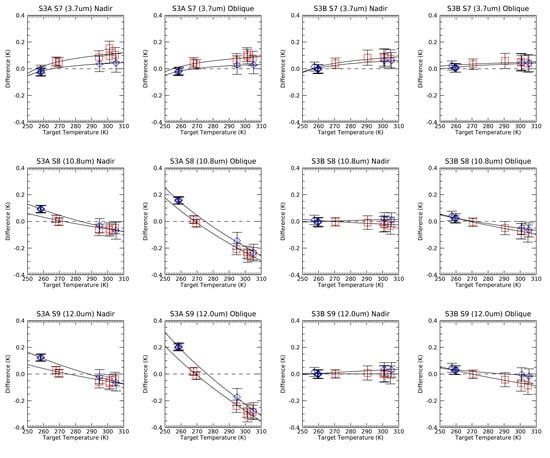Sentinel-3A/B SLSTR Pre-Launch Calibration of the Thermal InfraRed Channels
Abstract
1. Introduction
2. Methods and Tools
2.1. Calibration Scheme
2.2. Calibration Facility
2.3. Calibration Sources
2.4. Test Procedure
- IR detectors controlled at the flight operating temperatures of 87 K
- All detectors switched on
- Flight BBs at nominal operating conditions (one unheated at ~260 K and the other heated at ~302 K)
- Full scan cycle operating (nadir and oblique scanners and flip mechanism running)
- Nominal flight Target Position Table (TPT)
- All instrument science packets generated (all bands, scan and HK)
2.5. Analysis Method
2.6. Uncertainties
3. Results
3.1. Response vs. Temperature
3.2. Non-Linearity
3.3. Radiometric Noise
3.4. Comparisons with Scene Temperature
3.5. Comparisons with Different On-Board BB Temperatures
3.6. Response vs. Detector Temperature
3.7. Comparisons vs. Earth View
3.8. Orbital Simulation
4. Discussion
4.1. Stray Light’ Effect
- Configuration of the internal BBs
- Wavelength, with S9 (12 µm) being the worst affected.
- The thermal environment of the instrument.
- Appeared to be correlated with the external earth view baffle temperatures
- Stronger in oblique view than for nadir view
- Detector temperature
- Earth view position
- Optics temperatures
- External thermal environment
- Processing errors
- We can then deduce , and , from the measurements where X = 0 and X = 1.
- The physical source of the stray light signal must be within the vicinity of the main signal and determined by the measured temperatures. So, for the earth views these will be the external baffles, and for the internal BB sources these will be the optical enclosure.
4.2. S7 Emissivity
4.3. Saturation of S7
5. Conclusions
Author Contributions
Funding
Acknowledgments
Conflicts of Interest
References
- Ohring, G.; Wielicki, B.; Spencer, R.; Emery, B.; Datla, R. Satellite instrument calibration for measuring global climate change. Bull. Am. Meteorol. Soc. 2005, 86, 1303–1313. [Google Scholar] [CrossRef]
- Liua, X.; Wub, W.; Wielickia, B.A.; Yangb, Q.; Kizerb, S.H.; Huangc, X.; Chenc, X.; Katoa, S.; Sheaa, Y.L.; Mlynczaka, M.G. Spectrally Dependent CLARREO Infrared Spectrometer Calibration Requirement for Climate Change Detection. J. Clim. 2017, 30, 3979–3998. [Google Scholar] [CrossRef]
- Drinkwater, M.R.; Rebhan, H. Sentinel-3 Mission Requirements Document and References Therein. In Sentinel-3 Project Document, EOP-SMO/1151/MD-md; ESA, ESTEC: Noordwijk, The Netherlands, 2007; Available online: http://esamultimedia.esa.int/docs/GMES/GMES_Sentinel3_MRD_V2.0_update.pdf (accessed on 3 August 2020).
- Donlon, C.; Berruti, B.; Buongiorno, A.; Ferreira, M.-H.; Féménias, P.; Frerick, J.; Goryl, P.; Klein, U.; Laur, H.; Mavrocordatos, C.; et al. The Global Monitoring for Environment and Security (GMES) Sentinel-3 Mission. Remote. Sens. Environ. 2012, 120, 37–57. [Google Scholar] [CrossRef]
- Llewellyn-Jones, D.; Remedios, J. The Advanced Along Track Scanning Radiometer (AATSR) and its predecessors ATSR-1 and ATSR-2: An introduction to the special issue. Remote. Sens. Environ. 2012, 116, 1–3. [Google Scholar] [CrossRef]
- Závody, A.M.; Mutlow, C.T.; Llewellyn-Jones, D.T. A radiative-transfer model for sea-surface temperature retrieval for the Along-Track Scanning Radiometer. J. Geophys. Res. Ocean. 1995, 100, 937–952. [Google Scholar] [CrossRef]
- Coppo, P.; Ricciarelli, B.; Brandani, F.; Delderfield, J.; Ferlet, M.; Mutlow, C.; Munro, G.; Nightingale, T.; Smith, D.; Bianchi, S.; et al. SLSTR: A high accuracy dual scan temperature radiometer for sea and land surface monitoring from space. J. Mod. Opt. 2010, 57, 1815–1830. [Google Scholar] [CrossRef]
- Coppo, P.; Mastrandrea, C.; Stagi, M.; Calamai, L.; Nieke, J. Sea and Land Surface Temperature Radiometer detection assembly design and performance. J. Appl. Remote. Sens. 2014, 8, 084979. [Google Scholar] [CrossRef]
- Hawkins, G.; Sherwood, R.; Djotni, K.; Coppo, P.; Höhnemann, H.; Belli, F. Cooled Infrared Filters and Dichroics for the Sea and Land Surface Temperature Radiometer (SLSTR). Appl. Opt. 2013, 52, 2125–2135. [Google Scholar] [CrossRef] [PubMed]
- Mason, I.M.; Sheather, P.H.; Bowles, J.A.; Davies, G. Blackbody calibration sources of high accuracy for a spaceborne infrared instrument: The along Track Scanning Radiometer. Appl. Opt. 1996, 35, 629–639. [Google Scholar] [CrossRef] [PubMed]
- Nightingale, T.J.; McPheat, R.; Smith, D.L.; Mortimer, H.; Polehampton, E.; Lee, A. Sentinel-3A/B SLSTR spectral response calibration (Manuscript in preparation).Spectral Responses and Test Reports are Available for Download at. Available online: https://sentinel.esa.int/web/sentinel/technical-guides/sentinel-3-slstr/instrument/measured-spectral-response-function-data (accessed on 23 June 2020).
- SLSTR BlackBody Subsystem & Temperature Acquisition Electronics Technical Budgets Report. In Sentinel-3 Project Document, S3-RP-ABS-SL-0017; ESA, ESTEC: Noordwijk, The Netherlands, 2012.
- Peters, D.; Etxaluze, M.; Smith, D. Report on BBS Emissivity and Sensitivity to Temperature Gradients. In Sentinel-3 Project Document, S3-RP-RAL-SL-114; RAL Space: Harwell, UK, 2018. [Google Scholar]
- Smith, D.L.; Nightingale, T.J.; Mortimer, H.; Middleton, K.; Edeson, R.; Cox, C.V.; Mutlow, C.T.; Maddison, B.J.; Coppo, P. Calibration approach and plan for the sea and land surface temperature radiometer. J. Appl. Remote. Sens. 2014, 8, 84980. [Google Scholar] [CrossRef]
- Smith, D.; Mutlow, C.; Delderfield, J.; Watkins, B.; Mason, G. ATSR infrared radiometric calibration and in-orbit performance. Remote. Sens. Environ. 2012, 116, 4–16. [Google Scholar] [CrossRef]
- Mason, G. Test and Calibration of the Along Track Scanning Radiometer, A Satellite-Borne Infrared Radiometer Designed to Measure Sea Surface Temperature. Ph.D. Thesis, University of Oxford, Oxford, UK, 1991. [Google Scholar]
- Monte, C. ATSR BB Emissivity Measurements. Private Communication. 2012. Available online: https://ioccg.org/wp-content/uploads/2015/02/optical-radiometry-excerpt.pdf (accessed on 23 June 2020).
- Prokhorov, A.; Prokhorova, N.I. Application of the three-component bidirectional reflectance distribution function model to Monte Carlo calculation of spectral effective emissivities of nonisothermal blackbody cavities. Appl. Opt. 2012, 51, 8003–8012. [Google Scholar] [CrossRef] [PubMed]
- Theocharous, E.; Fox, N.P. CEOS comparison of the IR Brightness temperature measurements in support of satellite validation. Part II: Laboratory comparisons of the brightness temperature of blackbodies. NPL Rep. OP3 2010. Available online: http://eprintspublications.npl.co.uk/id/eprint/4744 (accessed on 3 August 2020).
- JASMIN. Available online: http://Jasmin.ac.uk (accessed on 4 June 2020).
- Joint Committee for Guides in Metrology, Evaluation of Measurement Data. Guide to the Expression of Uncertainty in Measurement (JCGM 100:2008). Available online: https://www.bipm.org/utils/common/documents/jcgm/JCGM_100_2008_E.pdf (accessed on 30 July 2019).
- Smith, D.; Hunt, S.; Wooliams, E.; Etxaluze, M.; Peters, D.; Nightingale, T.; Mittaz, J. Traceability of the Sentinel-3 SLSTR Level-1 Infrared Radiometric Processing. (Unpublished; Manuscript in preparation).
- Theocharous, E.; Ishii, J.; Fox, N.P. Absolute linearity measurements on HgCdTe detectors in the infrared region. Appl. Opt. 2004, 43, 4182–4188. [Google Scholar] [CrossRef] [PubMed]
- Yang, S.; Vayyshenker, I.; Li, X.; Scott, T. Accurate Measurement of Optical Detector Nonlinearity Proc. In Proceedings of the Natl. Conf. Stds. Labs., Chicago, IL, USA, 3 July–4 August 1994. [Google Scholar]
- Mavrocordatos, C. SLSTR LWIR channels calibration issue: Pre-launch Status. In Sentinel-3 Project Document S3-TN-ESA-SL-0663; ESA, ESTEC: Noordwijk, The Netherlands, 2016. [Google Scholar]
- Adibekyan, A.; Kononogova, E.; Monte, C.; Hollandt, J. High-Accuracy Emissivity Data on the Coatings Nextel 811–21, Herberts 1534, Aeroglaze Z306 and Acktar Fractal Black. Int. J. Thermophys. 2017, 38, 89. [Google Scholar] [CrossRef]
- Tomazic, I.; O’Carroll, A.; Hewison, T.; Ackerman, J.; Donlon, C.; Nieke, J.; Andela, B.; Coppens, D.; Smith, D. Initial comparison between Sentinel-3A SLSTR and IASI aboard MetOp-A and MetOp-B. GSICS Q. 2016, 10. [Google Scholar] [CrossRef]
- Hunt, S.E.; Mittaz, J.P.D.; Smith, D.L.; Polehampton, E.; Yemelyanova, R.; Woolliams, E.R.; Donlon, C. A Level 1 and Level 2 Comparison of the Sentinel-3A/B SLSTR Tandem Phase Data using Metrological Principles. Remote Sens. 2020. (Under review). [Google Scholar]
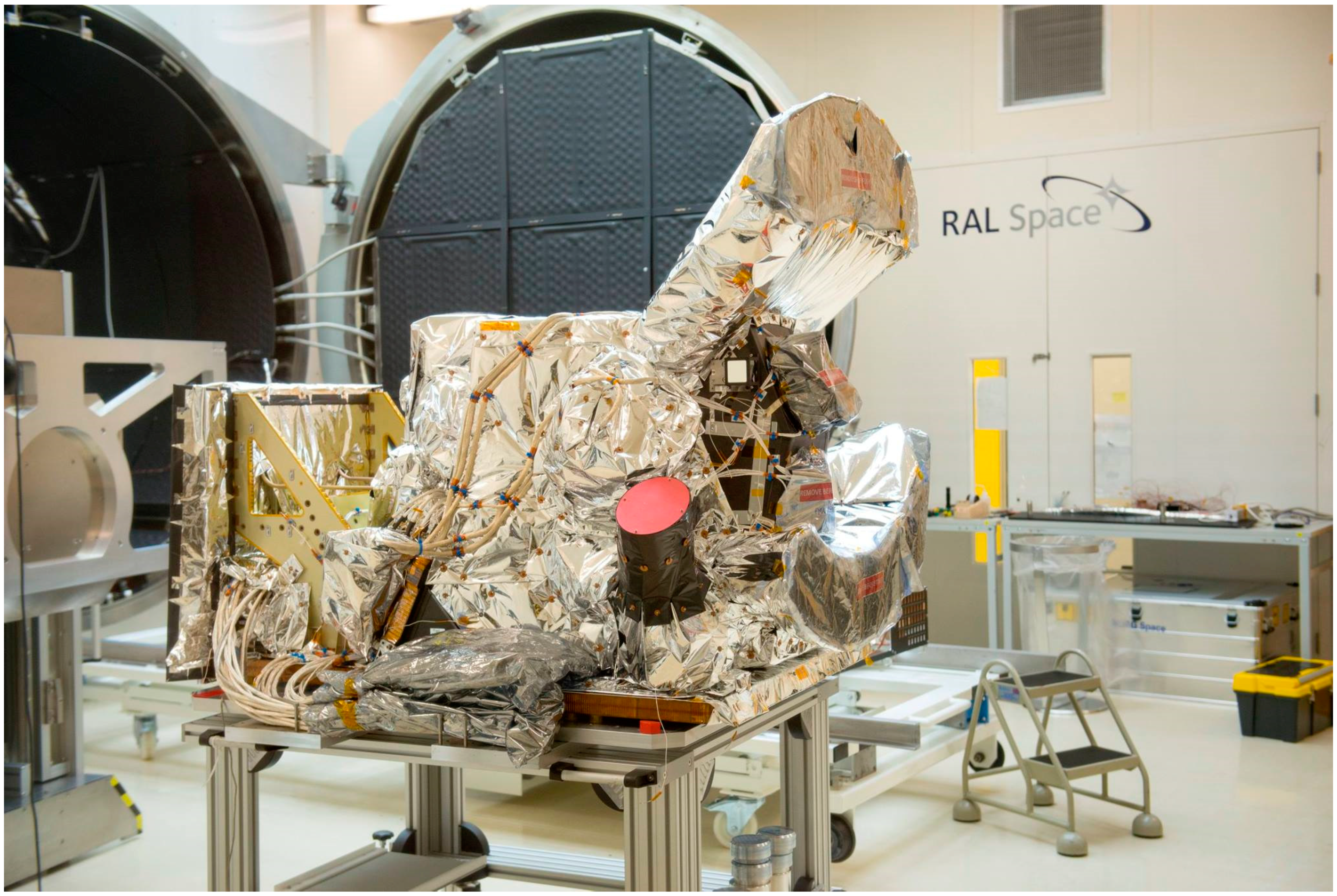

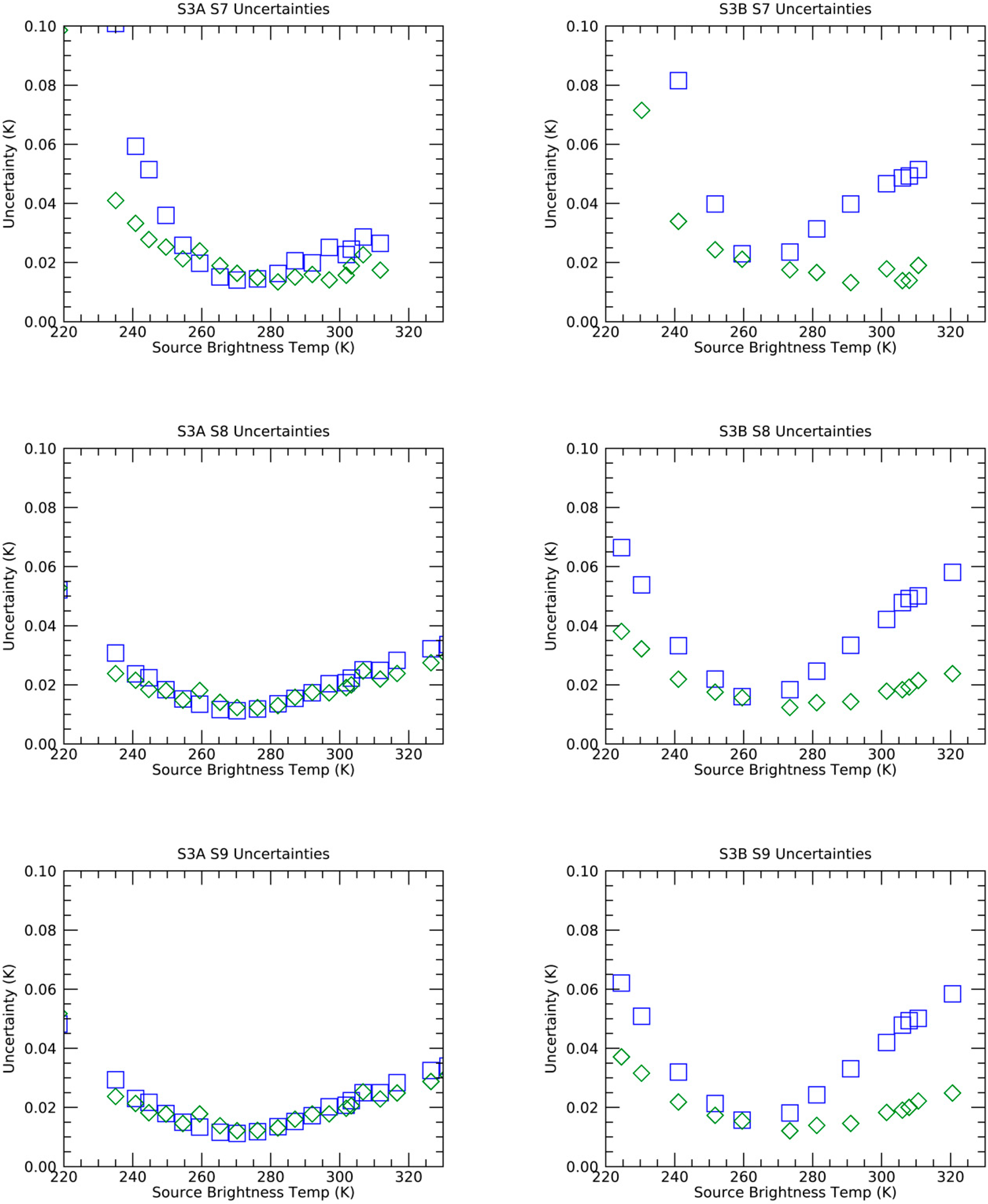

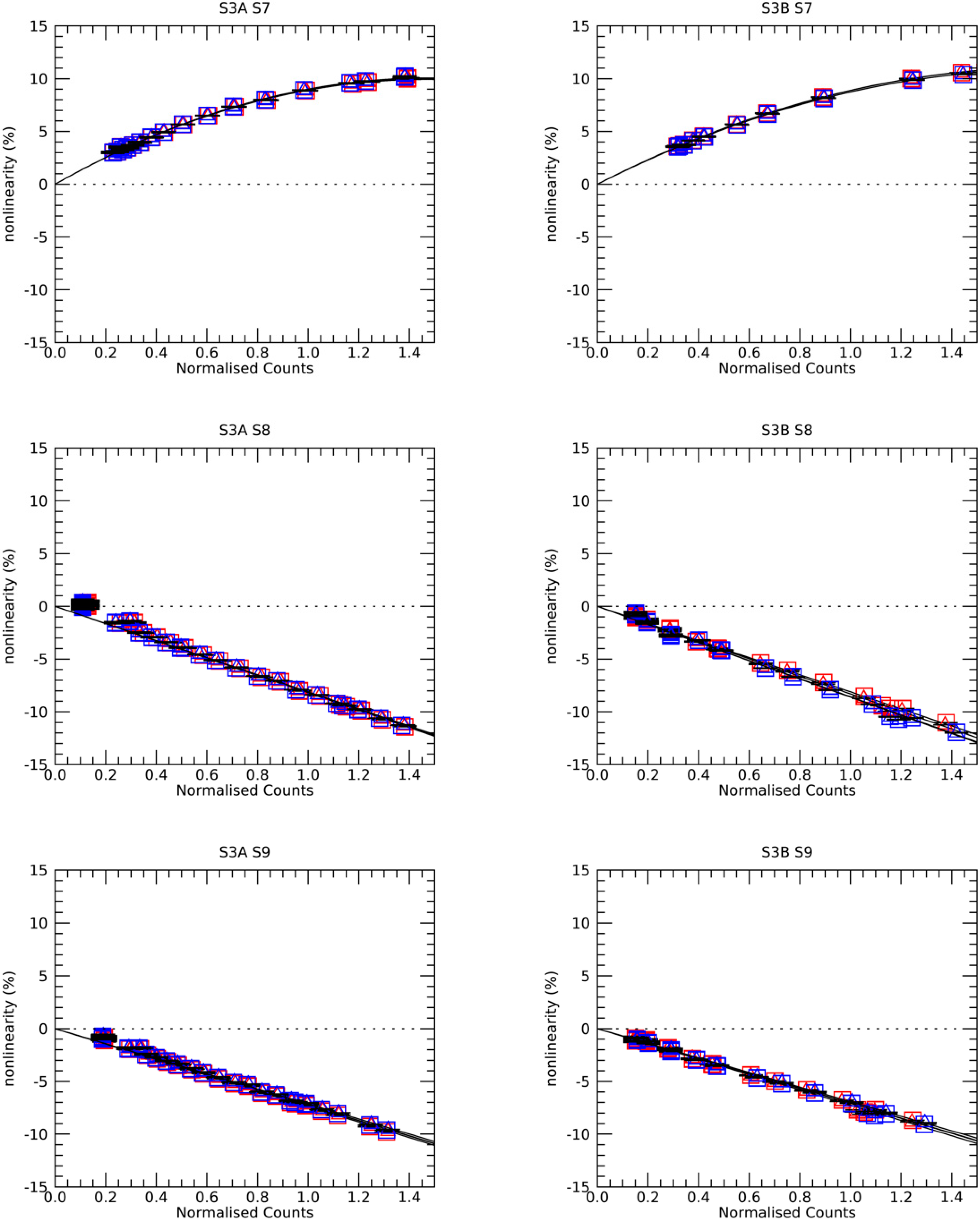
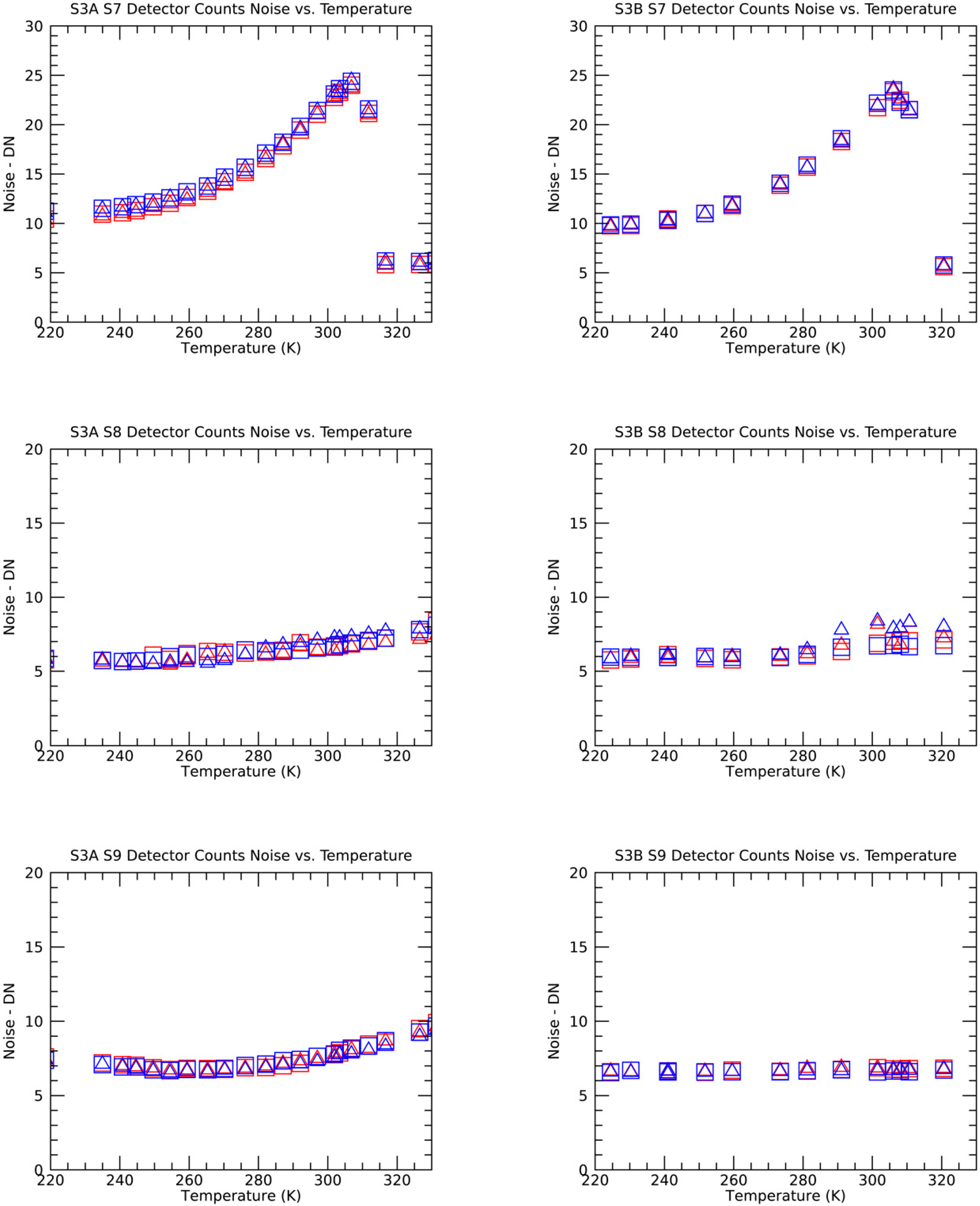
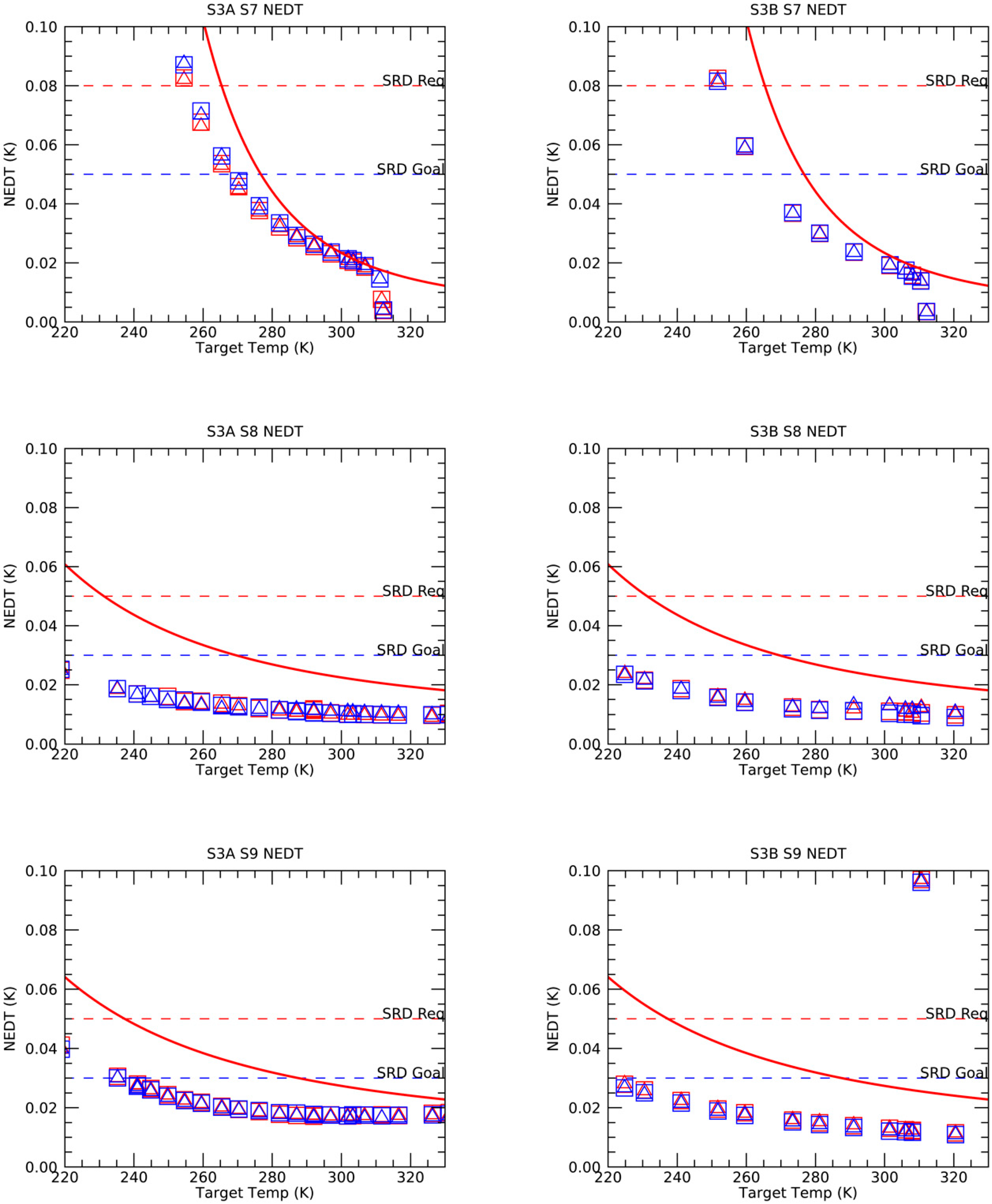

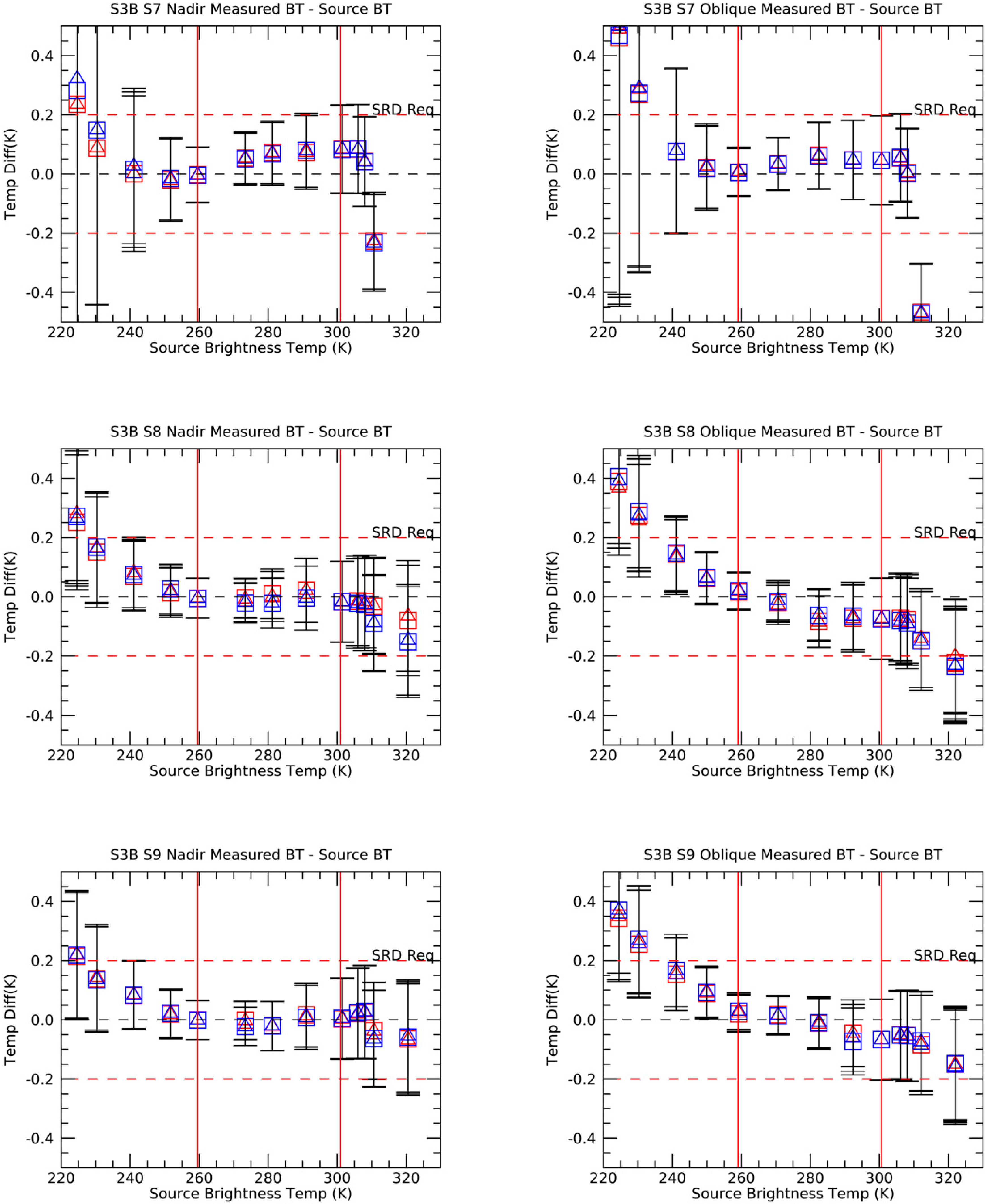
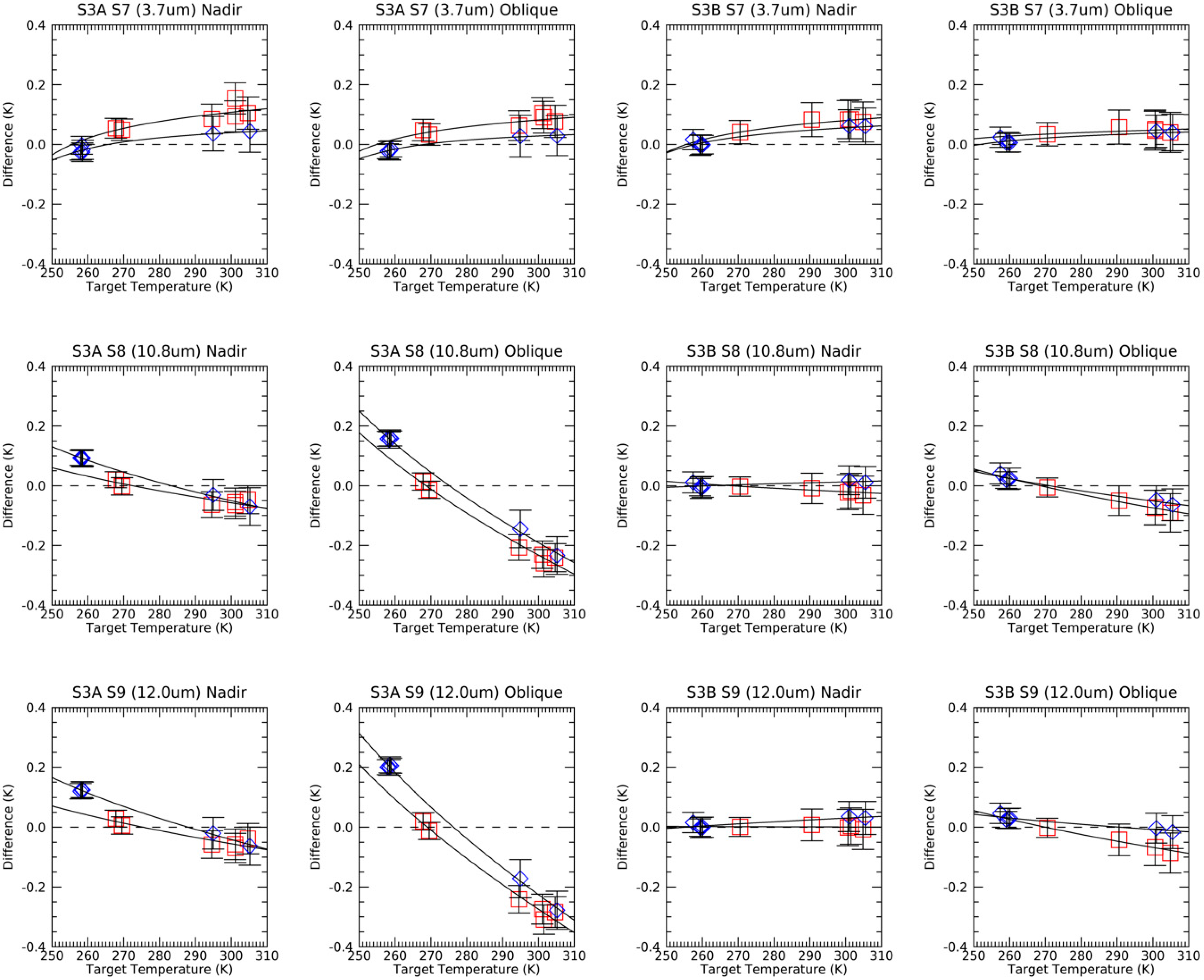
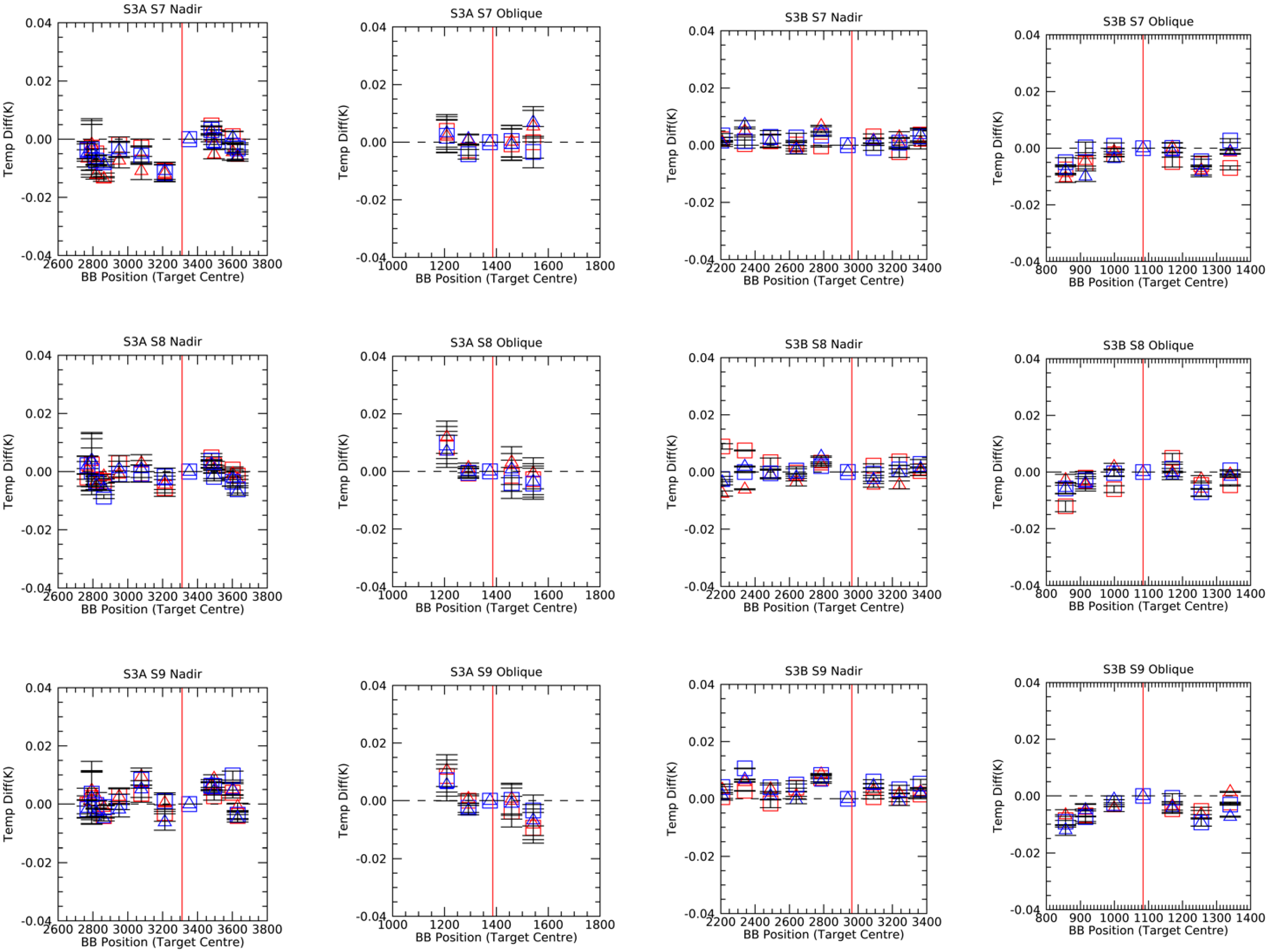
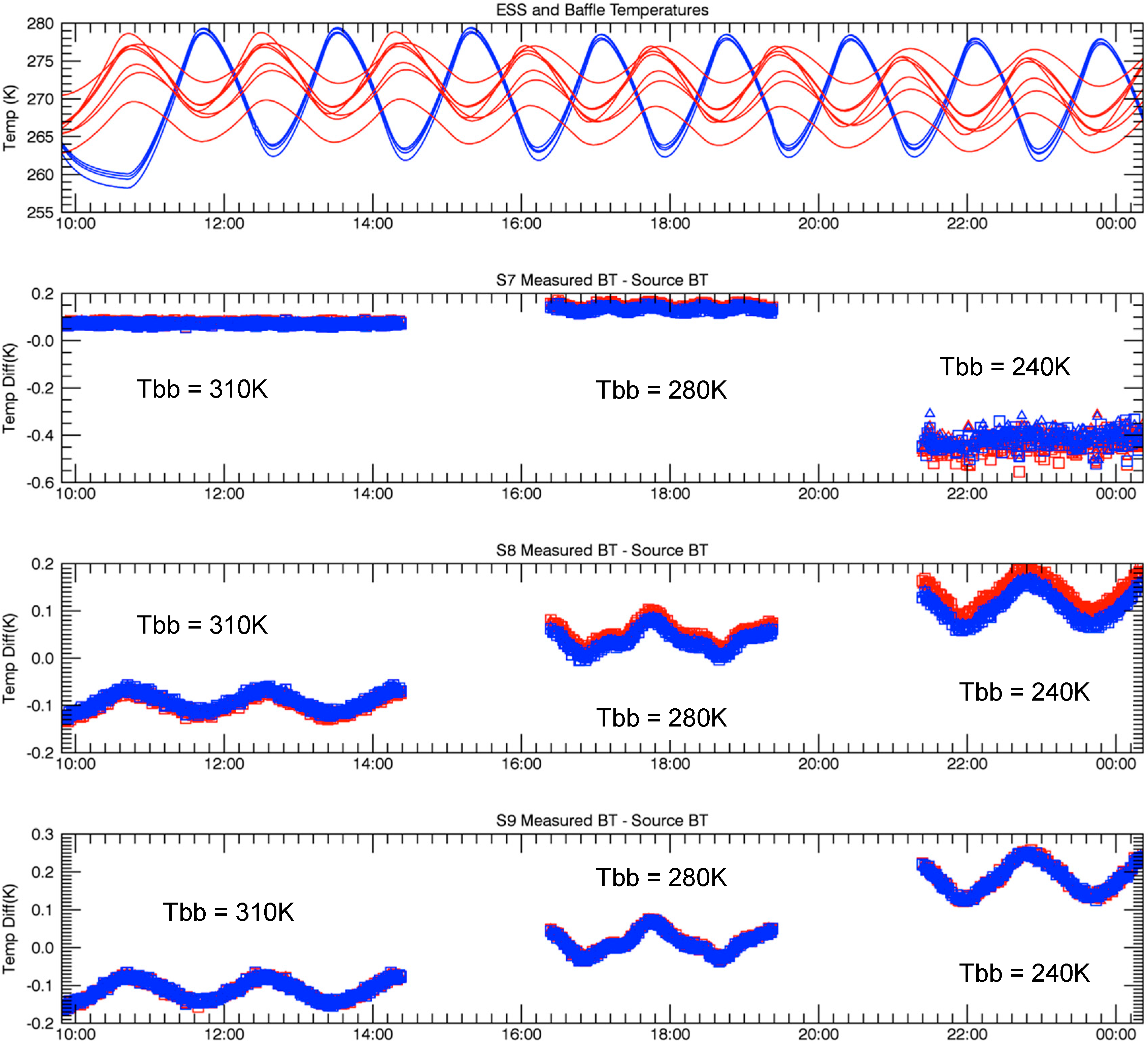

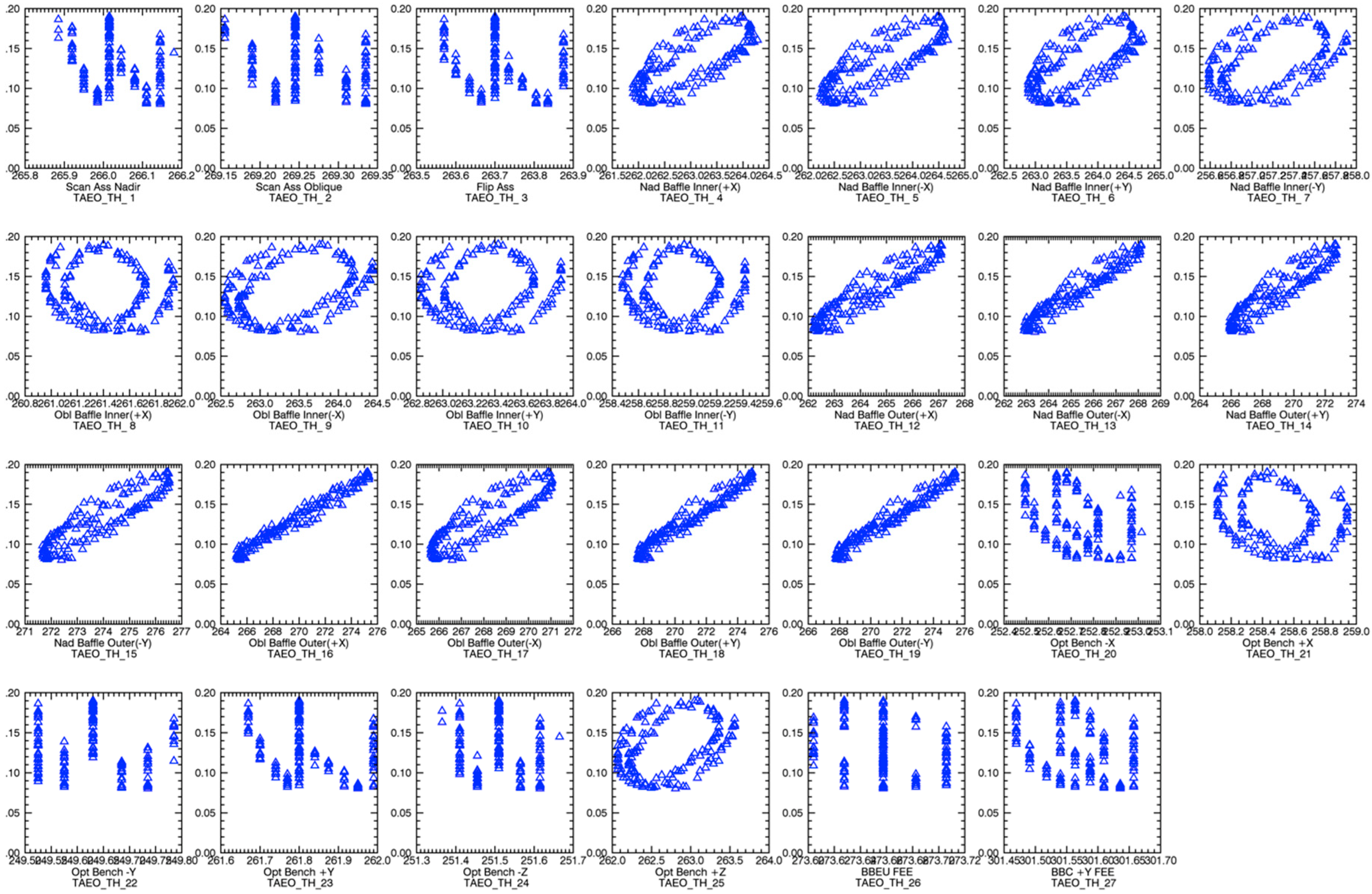

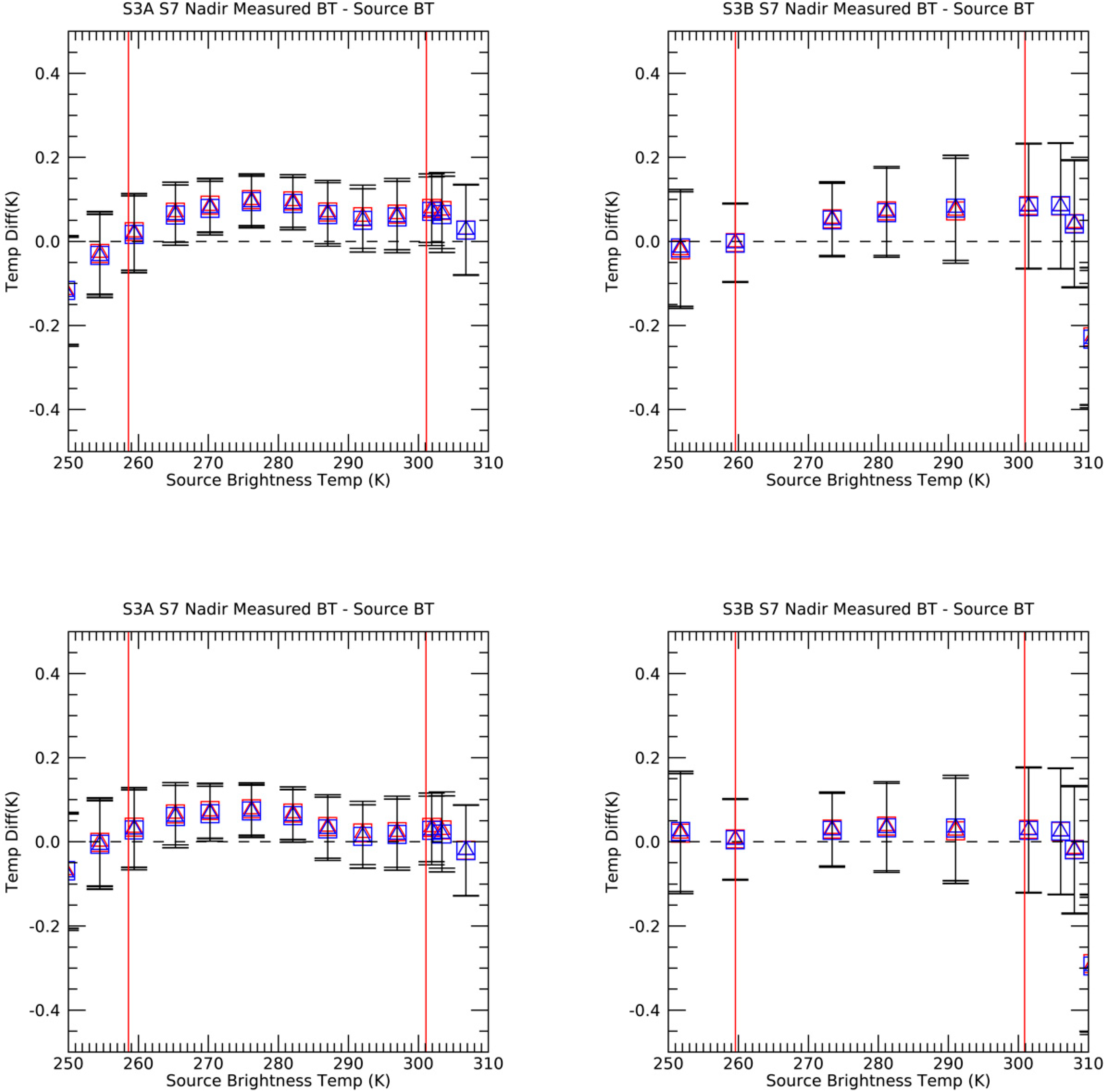

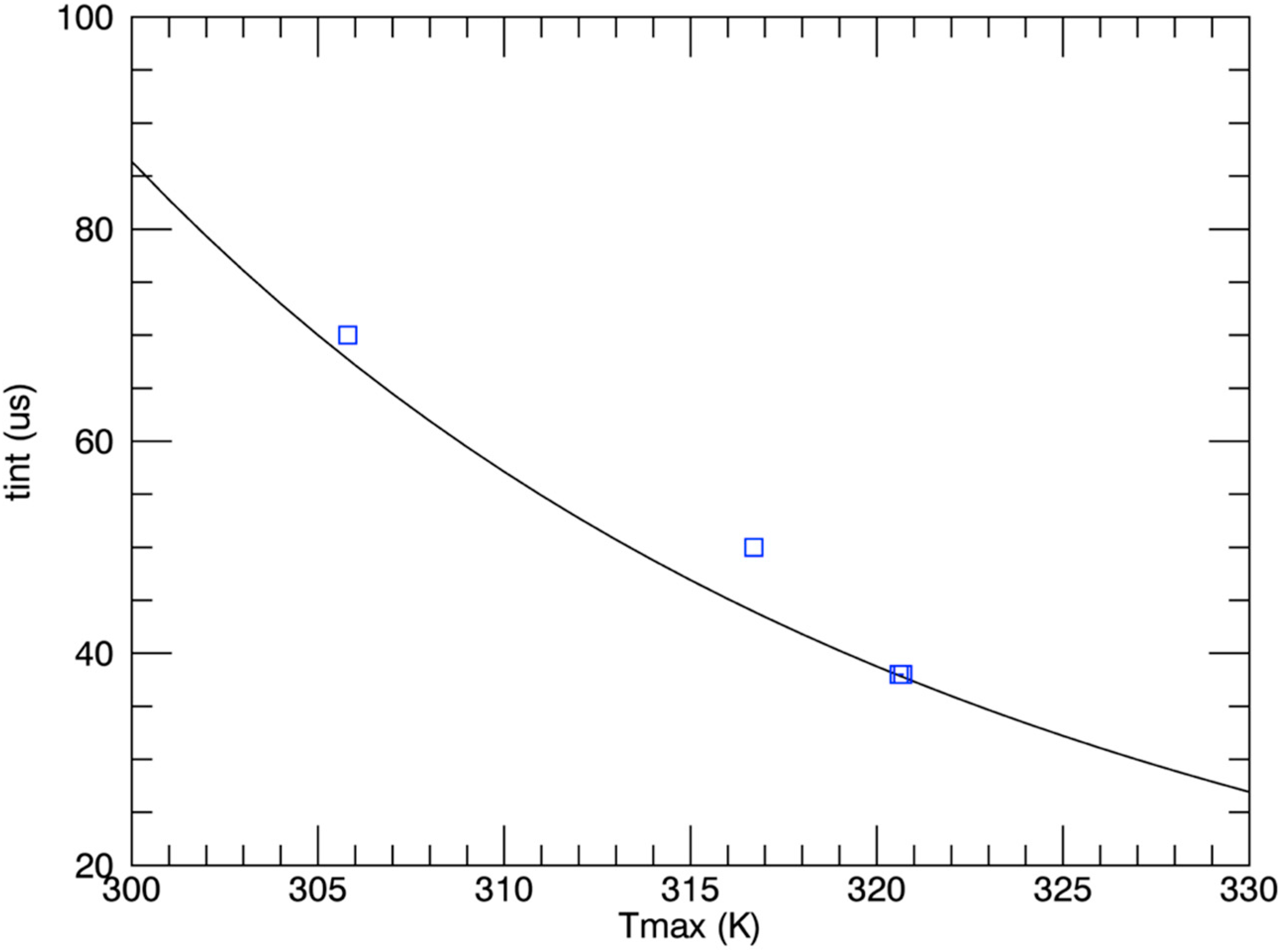
| Band Number | Central Wavelength (μm) | Bandwidth (μm) | Spatial Resolution at Nadir | Function |
|---|---|---|---|---|
| S1 | 0.555 | 0.020 | 0.5 km | Chlorophyll Dual-view AOD over land |
| S2 | 0.659 | 0.020 | 0.5 km | Vegetation Index Dual-view AOD over land |
| S3 | 0.870 | 0.020 | 0.5 km | Vegetation Index Dual-view AOD over land |
| S4 | 1.375 | 0.015 | 0.5 km | Thin Cirrus Cloud Detection |
| S5 | 1.610 | 0.060 | 0.5 km | Clouds, Fire, Ice/cloud discrimination |
| S6 | 2.225 | 0.050 | 0.5 km | Clouds, Fire |
| S7 | 3.700 | 0.380 | 1.0 km | Night-time dual-view SST, Fire |
| S8 | 10.850 | 0.900 | 1.0 km | Dual-view SST/LST |
| S9 | 12.000 | 1.000 | 1.0 km | Dual-view SST/LST |
| S7F | 3.700 | 0.380 | 1.0 km | Fire |
| S8F | 12.000 | 0.900 | 1.0 km | Fire |
| Spectral Band | Cavity Emissivity |
|---|---|
| 3.7 µm (S7, F1) | 0.99830 ± 0.00012 |
| 11 µm (S8, F2) | 0.99924 ± 0.00010 |
| 12 µm (S9) | 0.99915 ± 0.00010 |
| Emissivity | |||
|---|---|---|---|
| 3.7 µm | 11 µm | 12 µm | |
| Original Values | 0.99899 ± 0.00035 | 0.99847 ± 0.00036 | 0.99871 ± 0.00037 |
| ATSR-2/AATSR | 0.99911 ± 0.00055 | 0.99870 ± 0.00040 | 0.99871 ± 0.00032 |
| PTB—2012 | 0.99958 ± 0.00015 | 0.99917 ± 0.00030 | 0.99929 ± 0.00025 |
| Averages | 0.99923 | 0.99878 | 0.99890 |
| Max-Min | 0.00059 | 0.00070 | 0.00058 |
| Combined uncertainty (k = 1) | 0.00042 | 0.00041 | 0.00036 |
| Source | Uncertainty (mK) at Tscene = 270 K | ||
|---|---|---|---|
| 3.7 µm | 10.8 µm | 12.0 µm | |
| Calibration Sources | 17.8 | 18.0 | 18.1 |
| Spectral Response | 12.4 | 1.2 | 1.0 |
| Non-Linearity Response | 2.4 | 2.2 | 2.1 |
| Radiometric Noise * | |||
| Combined Standard Uncertainty (k = 1) | 21.8 | 18.2 | 18.2 |
| Combined Expanded Uncertainty (k = 3) | 65.5 | 54.5 | 54.7 |
| SLSTR-A | SLSTR-B | |||||||
|---|---|---|---|---|---|---|---|---|
| Nadir | Oblique | Nadir | Oblique | |||||
| Tmin | Tmax | Tmin | Tmax | Tmin | Tmax | Tmin | Tmax | |
| S7 | 240 * | 307 | 240 * | 307 | 240 | 307 | 240 | 307 |
| S8 | 205 | >330 ** | 204 | >330 ** | 206 | >330 ** | 206 | >330 ** |
| S9 | 189 | >330 ** | 187 | >330 ** | 205 | >330 ** | 205 | >330 ** |
| Model | Channel | Tdet (K) | NEΔT (K) | Calibration Slope (W·m−2·sr−1·µm−1) | Tdet (K) | NEΔT (K) | Calibration Slope (W·m−2·sr−1·µm−1) |
|---|---|---|---|---|---|---|---|
| SLSTR-A | S7 | 84.3 | 0.046 | 1.9039 × 10−5 | 89.2 | 0.046 | 1.9263 × 10−5 |
| S8 | 85.7 | 0.013 | 2.1987 × 10−4 | 90.6 | 0.015 | 2.5789 × 10−4 | |
| S9 | 86.3 | 0.020 | 2.7104 × 10−4 | 91.2 | 0.026 | 3.5896 × 10−4 | |
| SLSTR-B | S7 | 85.3 | 0.033 | 1.5534 × 10−5 | 92.9 | 0.046 | 1.8036 × 10−5 |
| S8 | 85.3 | 0.014 | 2.6192 × 10−4 | 92.7 | 0.021 | 3.0744 × 10−4 | |
| S9 | 85.6 | 0.017 | 2.5396 × 10−4 | 92.9 | 0.027 | 3.5049 × 10−4 |
| Instrument Model | View | Channel | wstray | Lstray (W·m−2·sr−1·µm−1) | Tstray (K) |
|---|---|---|---|---|---|
| SLSTR-A | Nadir | S8 | 0.003 | 6.883 | 280 |
| S9 | 0.004 | 7.001 | 280 | ||
| Oblique | S8 | 0.010 | 6.196 | 272 | |
| S9 | 0.012 | 5.983 | 273 | ||
| SLSTR-B | Nadir | S8 | 0.000 | 4.358 | - |
| S9 | −0.000 | 3.681 | 246 | ||
| Oblique | S8 | 0.002 | 5.750 | 269 | |
| S9 | 0.002 | 5.996 | 273 |
| Instrument Model | View | Channel | wstray,scene | wstray,bb1/bb2 | ρblack |
|---|---|---|---|---|---|
| SLSTR-A | Nadir | S8 | 0.0110 | 0.0095 | 5% |
| S9 | 0.0120 | 0.0090 | |||
| Oblique | S8 | 0.0120 | 0.0350 | 10% | |
| S9 | 0.0158 | 0.0500 | |||
| SLSTR-B | Nadir | S8 | 0.0044 | 0.0014 | 2% |
| S9 | 0.0060 | 0.0025 | |||
| Oblique | S8 | 0.0048 | 0.0038 | 5% | |
| S9 | 0.0079 | 0.0045 |
| SLSTR-A | SLSTR-B | |||||
|---|---|---|---|---|---|---|
| εreported | Δε | εcorrected | εreported | Δε | εcorrected | |
| +YBB | 0.99830 ± 0.00012 | −0.0020 ± 0.0020 | 0.9963 ± 0.0020 | 0.99830 ± 0.00012 | −0.0025 ± 0.0020 | 0.9958 ± 0.0020 |
| −YBB | 0.99830 ± 0.00012 | −0.0045 ± 0.0020 | 0.9938 ± 0.0020 | 0.99830 ± 0.00012 | −0.0030 ± 0.0020 | 0.9953 ± 0.0020 |
| NEΔT at 270 K | Tint = 70 µs | Tint = 50 µs | Tint = 38 µs | EOL Req. Goal/Threshold |
|---|---|---|---|---|
| S7 | 40 mK | 50 mK | 60 mK | 50 mK/80 mK |
| S8 | 18 mK | 19 mK | 20 mK | 30 mK/50 mK |
| S9 | 20 mK | 25 mK | 30 mK | 30 mK/50 mK |
© 2020 by the authors. Licensee MDPI, Basel, Switzerland. This article is an open access article distributed under the terms and conditions of the Creative Commons Attribution (CC BY) license (http://creativecommons.org/licenses/by/4.0/).
Share and Cite
Smith, D.; Barillot, M.; Bianchi, S.; Brandani, F.; Coppo, P.; Etxaluze, M.; Frerick, J.; Kirschstein, S.; Lee, A.; Maddison, B.; et al. Sentinel-3A/B SLSTR Pre-Launch Calibration of the Thermal InfraRed Channels. Remote Sens. 2020, 12, 2510. https://doi.org/10.3390/rs12162510
Smith D, Barillot M, Bianchi S, Brandani F, Coppo P, Etxaluze M, Frerick J, Kirschstein S, Lee A, Maddison B, et al. Sentinel-3A/B SLSTR Pre-Launch Calibration of the Thermal InfraRed Channels. Remote Sensing. 2020; 12(16):2510. https://doi.org/10.3390/rs12162510
Chicago/Turabian StyleSmith, Dave, Marc Barillot, Stephane Bianchi, Fabio Brandani, Peter Coppo, Mireya Etxaluze, Johannes Frerick, Steffen Kirschstein, Arrow Lee, Brian Maddison, and et al. 2020. "Sentinel-3A/B SLSTR Pre-Launch Calibration of the Thermal InfraRed Channels" Remote Sensing 12, no. 16: 2510. https://doi.org/10.3390/rs12162510
APA StyleSmith, D., Barillot, M., Bianchi, S., Brandani, F., Coppo, P., Etxaluze, M., Frerick, J., Kirschstein, S., Lee, A., Maddison, B., Newman, E., Nightingale, T., Peters, D., & Polehampton, E. (2020). Sentinel-3A/B SLSTR Pre-Launch Calibration of the Thermal InfraRed Channels. Remote Sensing, 12(16), 2510. https://doi.org/10.3390/rs12162510




